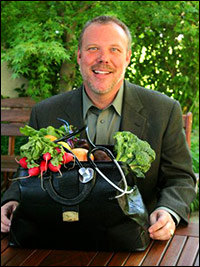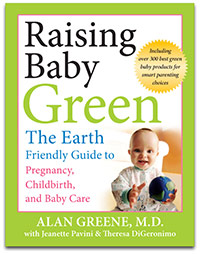If you were to give a check-up to Alan Greene, eco-pediatrician extraordinaire, you just might diagnose him with ASHD — Attention Surplus Hyperproductivity Disorder. It isn’t a real disorder, of course. But whatever Greene’s got — whatever blend of vim and vision allows him to stay at the cutting edge of environmentalism and e-medicine while also writing books, doctoring, and being a 100-percent-organic-food-eating father of four — well, it’s something that’s helped the world get better.

Dr. Alan Greene.
Consider: In 1995, Greene and his wife Cheryl sat down at their kitchen table in San Mateo, Calif., and launched the world’s first pediatric website, DrGreene.com. It grew into a behemoth, providing advice, virtual house calls, and information that attracted 50 million hits per month. Since then, Greene has written three books on children’s health and parenting. He’s been a trailblazer in the internet-for-health movement; he helped draft standards and ethics for medical websites (in 2000 he wrote the Millennium Oath, a pledge for physicians to use open communication with patients instead of the secrecy urged in the Hippocratic Oath). He’s also a pediatrician at Packard Children’s Hospital in Palo Alto, a professor at the Stanford University School of Medicine, and a pediatric expert for WebMD and other outlets. He even wears green socks.
We reached Greene this month to ask him about his latest success — the just-released book Raising Baby Green: The Earth-Friendly Guide to Pregnancy, Childbirth, and Baby Care — and to hear his surprising views about parent power.
You’ve spent years as pediatrician and answered nearly every question known to parenthood on your website. Why did you want to write this book?

A few years ago I did a study with the Environmental Working Group where we measured umbilical cord blood in babies. We found an average of 200 different industrial chemicals in their cord blood at birth. Of the total 287 chemicals we detected, 180 are known to cause cancer in humans and 217 are toxic to the brain and nervous system. So I realized that what’s “out there” is in us — even in the most inner sanctum of the womb. Being green and getting pregnant and raising a baby are so intimately connected, I just had to explore the impact of the environment on babies, and vice versa.
Have you seen positive research findings, too?
Definitely. Take pesticides: there was a great study done in 2006: researchers took typical kids in a suburb outside of Seattle, and they did urine testing and found high levels of organophosphorus pesticides, which are very widely used. They’re actually more dangerous than DDT: they’re linked to ADHD and developmental delays and lowered testosterone levels in adult men. But they’re not long-acting the way DDT was. And what the researchers did was switch the children to a mostly organic diet, with organic foods that parents could buy at the local store. And in 24 hours they had lower pesticide levels.
That’s pretty encouraging — that one of the biggest threats to children’s health can be reversed in a single shopping trip.
What can you do if you can’t afford an all-organic lifestyle?
Another reason I wrote the book was to put these things in perspective and make things as simple as possible. What you can do, for example, is try to eat organic foods at least during pregnancy, when babies are the most vulnerable. Pregnancy is also a time when you have the most control. The baby is only going to be exposed to what goes on your skin, what goes in your mouth, and the fumes you inhale.
And, again, it’s possible to turn things around. Researchers have been looking at bisphenol A, one of the nasty plasticizers that are all over the place, and they gave it to pregnant animals. Then they gave the animals extra levels of folate and genistein [an active ingredient in soy], and it erased the damage. Getting great phytochemicals and antioxidants in your diet during pregnancy can go a long way.
What are you seeing that’s not so heartening?
A lot of the environmental diseases are getting worse. Asthma has tripled or quadrupled in recent decades, peanut allergies have doubled in a five-year period — and they can be very serious. Cancers are also on the rise across the board. There’s been a 250 percent increase in ADHD. Autism is on the rise: the incidence used to be 1 in 10,000; now it’s 1 in 166. It used to be that doctors saw high cholesterol, and glucose tolerance out of whack, and out-of-control waist sizes in middle-aged people. Today, about two-thirds of high-school students already have one of those problems. Type-2 diabetes, which used to be called adult-onset diabetes, is really on the rise — we’re seeing it starting in fourth grade. We have a ticking diabetic time bomb.
We’re giving kids too many calories, too many ingredients that kids’ bodies don’t know how to deal with, and diets so unbalanced that kids are missing out on many of the protective nutrients they need. Obesity is very, very common.
What are parents worrying about more than they should?
The first question I usually get is, “What diaper should I use?” The whole diaper thing is blown way out of perspective! Look at the Sunday edition of The New York Times: that one edition kills more trees, clogs up more landfills, and is a much bigger environmental problem than diapers. Research shows that the total impact of a child wearing diapers for a year — whether you’re using cloth or disposables — is about equal to burning up 54 gallons of gasoline. So it’s a small thing, comparatively speaking.
The key is to choose whatever diaper seems right, and then try to reduce the impacts. For disposable diapers, the big impacts come during manufacturing, so you should choose brands that aren’t made with chemicals like chlorine. For cloth diapers, the issues are the fuel used to transport them and the water and electricity used to wash them. If you use a delivery service, find one that has biodiesel or hybrid vehicles. If you wash them at home, use a nontoxic detergent. Another option is hybrid diapers like gDiapers. They’re an environmentally sound outer diaper that’s reusable, with an insert that’s flushable.
Is there one piece of green furniture that’s a must-have?
The mattress. Children sleep on that more than 12 hours a day, so an organic mattress is important. The whole incidence of SIDS [sudden infant death syndrome] decreased dramatically when we started putting kids to sleep on their backs, but I think part of the problem also came from children having their faces down in all the chemicals in conventional mattresses: polyvinyl chloride, phthalates, polyurethane foam, fire retardants.
What can we do if our older children slept on non-organic mattresses when they were babies, and we didn’t know any better?
Even if kids come into contact with something harmful, a lot can be done with them at any age to repair the damage. It can be done with great foods: organic, raw foods that are rich in antioxidants. A daily vitamin and mineral pill is also a great safety net. Even better than that is finding foods that you can teach them to like. Berries are a wonderful source of nutrition. So are cherries, and kids love them frozen without the pits.
You’ve written on dozens of enviro issues. Which one tops your list?
I’m working most on the food front, and my reasoning is that every bite of food we take is an investment we make in our bodies — or a debt we take out. It’s a vital and immediate impact. And it also impacts our air, land, streams, and global warming. If just 10 percent of our food supply were organic, it would be the equivalent of taking millions of cars off the roads. On farms, about 40 percent of the oil use comes from the use of chemical fertilizers and pesticides that are all oil-based.
Any last words of advice for frazzled parents?
Pick your battles. And relax. Kids are extremely resilient — there’s a lot of time for them to overcome things. And even little changes can make a big, positive difference.
